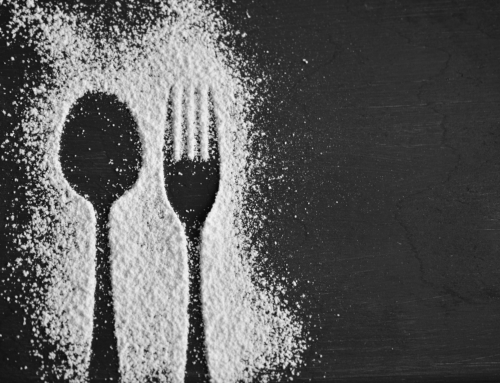It’s the end of a long day. End of a long week. I planned on getting some work done but am just ready to get into my pajamas and zone out on a funny movie. I change, wash the day off my face and take a deep breath. I have to walk through the kitchen to get to the living room and I feel the desire to get a snack—to find something sweet.
It’s like my whole body wants food, but my mind reminds me of how intense my morning workout was, and how emotionally eating will negate any calories burned. I recognize that I’m tired. I recognize that it’s been a stressful week. I recognize that it’s late and food won’t make me feel better. I recognize that I’m not hungry.
I recognize that I’m falling right into my old habit. The habit of emotional eating.
A history of emotional eating
Having struggled in the past with emotional eating, nowadays I’m grateful I have the tools to change the habit. I’ve kept eighty pounds off for over a decade now by learning how to change my relationship to food; especially my relationship to emotional eating.
I’ve done it by witnessing, slowing down and understanding that I don’t actually have hunger for food, but emotional hunger. In those times, I’m looking for a way to soothe myself. In the past, I conditioned myself to use food.
It started with a reasonable snack. Then more of that snack. Then another serving. Then pretty soon, the whole container was gone. Sugar. Sweet. Sugar. Sweet. More sugar. More. More. More. It was like it wasn’t even me eating. Then came the shame and guilt. More shame. More guilt. Self-loathing and unkind thoughts permeated my mind, body and soul. My thoughts hurt.
I was trapped in this cycle for decades. When I decided to take control of my health in 2008, I knew this cycle needed to change. I knew that I was ready.
Why diets don’t work—it’s a mindset shift
I came to understand that it was going to be a mindset shift. I had tried every fad diet and weight loss pill out there (which worked short term), but nothing helped me keep weight off long-term. I needed to make lasting changes in my lifestyle and relationship to food. I needed to understand why I was emotionally eating.
I’ve learned that diets don’t work. They’re based on elimination, deprivation and restriction. Taking it out of my diet only made me want it more—like it was the forbidden fruit that I couldn’t have. And that’s why I crashed even harder when I practiced that kind of “dieting.” As an emotional eater, I’ve learned that no diet in the world will help because they don’t fix what’s going on in the mind, which is where all of our actions stem from. All actions—whether emotional eating or not—come from our thoughts.
It wasn’t until I started incorporating mindfulness, meditation and yoga into my relationship with food that I experienced lasting change.
Through these practices, I was able to witness the emotional eater within. I was able to see habits of self-sabotage.
I learned to love those pieces of myself that suffered and used food to cope.
I needed to first change my relationship to myself and then to food. I began to see food as something to nurture me—as something to really feed me. So, sugar had to go. Sugar is an addiction and I was ready to stop tricking my brain with this nutritionally void chemical. I realized it kept me trapped in an up and down roller coaster cycle of feeling good and crashing, feeling good and crashing.
I decided I was worth more. I developed compassion for where I was and decided I was ready for the lasting change I so desired.
So, healing my emotional eating needed to start with healing the relationship to myself. I began with feeling worthy. I never felt worthy or deserving of health. So I needed to shift my relationship with myself.
6 Steps to Stop Emotional Eating
These are the tools I used—and still use to this day—to overcome emotional eating.
1. Feeling worthy
I began meditating with the mantra “I am enough.” I filled the emotional void and emotional cravings with these words and stopped paying attention to all the past experiences where my mind said that I was unworthy. I created new pathways of “enoughness” in my brain to get my mindset on a more positive track.
2. Compassion
I added “Loving Kindness Meditation” to my day. I didn’t limit my meditations to just ten or twenty minutes a day—I practiced meditating all day long. That is how I saw change so quick. I was committed to my practice, because I was sick-and-tired of feeling sick-and-tired. I would practice this particular meditation in the shower, no matter how much my mind argued with me! I silently repeated “May I be free from pain and suffering. May I be peaceful and at ease. May I be happy and healthy.” Beginning my practice from a place of self-loathing, this meditation was extremely difficult for me—but I kept practicing. Within a few weeks, I noticed my inner critic had become quieter and quieter.
3. Turn off auto-pilot with mindfulness
Instead of going about my day with typical patterns and unconscious habits, I used mindfulness to pay attention on purpose. I became aware of routine daily activities like brushing my teeth and washing the dishes. I extended this witnessing to chores and work. I became conscious of my actions, instead of falling into the patterns of old habits.
This practice of paying attention was particularly useful when I was eating. I was present when I prepared my food. I sat with it for a moment before eating and looked at it. I felt it in my mouth. I began chewing my food longer. I felt myself swallow and slowed down. It helped me to change my relationship to food drastically. I went from unconsciously shoveling food to slowly feeling and enjoying the act of eating. Previously, I’d make a dozen Krispy Kreme donuts disappear in a matter of minutes, without ever tasting them. I’d then travel down the familiar spiral of shame and guilt. Instead, I retrained my brain to be consciously aware of what I put in my body and what really nurtures me. I was able to make better choices about what I put in my body. I was able to feel when I was full and avoid overeating or binging.
4. Food-Mood connection
Once I started to slow down and practice mindful eating, I noticed the connection to certain foods and my moods. Having cut processed sugar out of my diet, I was more sensitive to it.
The same went for cutting out gluten and dairy, to eliminate inflammation and digestive problems.
Once I stopped eating those foods, I was able to really feel it if I added them back. I had given myself two weeks without these foods. Then I had some. Wow, did I become aware of their effects on me—especially the sugar-fueled symptoms of depression!
These foods made me feel so bad that I removed them from my diet completely.
After that, there was no more struggle or desire for those foods.
I was able to draw a direct correlation between ingesting those foods and the way I felt. And once I had shined the light of awareness on this, there was simply no going back. Oreos looked like round, chocolate bites of digestive distress. Candy bars looked like bouts of depression and anxiety.
Because I knew how I felt after ingesting these foods, it was more important to me to feel good than the brief high of eating junk. This practice extended to all the foods I was eating. I was able to become keenly aware of how food affects my mood.
That is why I always reach for foods filled with life, nutrients, the sun’s energy and taste.
5. Yoga
Movement was so important for digestion. And so was relaxation. I found that the perfect balance of action and non-action was essential for weight loss and feeling good about my physical and emotional body. Yoga united my body, mind and spirit, allowing me to be myself more. The simple act of being true to myself brought tremendous healing and empowerment.
Living disconnected from both my emotional and physical bodies got me in the unhealthy place I was before facing death at 30 years old. Yoga was able to turn that connection on and remind me what matters most.
I stopped believing everyone who had told me I wasn’t good enough or I shouldn’t be true to myself.
I stopped believing the cruel voices in my head that I had inherited from family and friends.
I finally gave myself permission to be me and life has never been more balanced or sweeter.
6. Change the story
There are times when I need to emotionally eat—still. The difference now is that I’m aware of it and I have a limit. I also “emotionally” eat things like apples and peanut butter or gluten free crackers and hummus. Big difference between that and five bags of M&M’s.
I changed the story in my head after I eat. I no longer berate myself for “bad decisions.” Instead, I fully and compassionately embrace the experience of the moment—if I need to comfort myself with food, it’s okay. And it’s okay for this particular circumstance, because it was my conscious choice. I felt empowered to make the decision to emotionally eat, rather than feeling like a victim, trapped in an unhealthy habit.
I changed the story from hate to love, embracing myself exactly as imperfect as I was.
Lasting change: repairing my relationship with food
These tools finally gave me the lasting change I so desperately sought. When I have old emotional eating habits appear, I’m able to witness them with compassion and understanding.
I’m able to ask myself, “What are you really hungry for?”
Sometimes, I just need to be wrapped in a blanket for comfort or to lie down and read. Sometimes I’m dehydrated and I need a glass of water. I can tune in, connect to my body, and ask it what it really needs. I’ve discovered that most of the time, it’s not food.
This has all been an unlearning of using food to cope and instead a journey of discovery, learning what I really need and how I can soothe myself. It has been an empowering journey of self-discovery where I’ve learned how I can truly take care of myself and not give my power or health away.
Exchanging the unhealthy patterns for healthy habits—that’s the way I freed myself from emotional eating.





